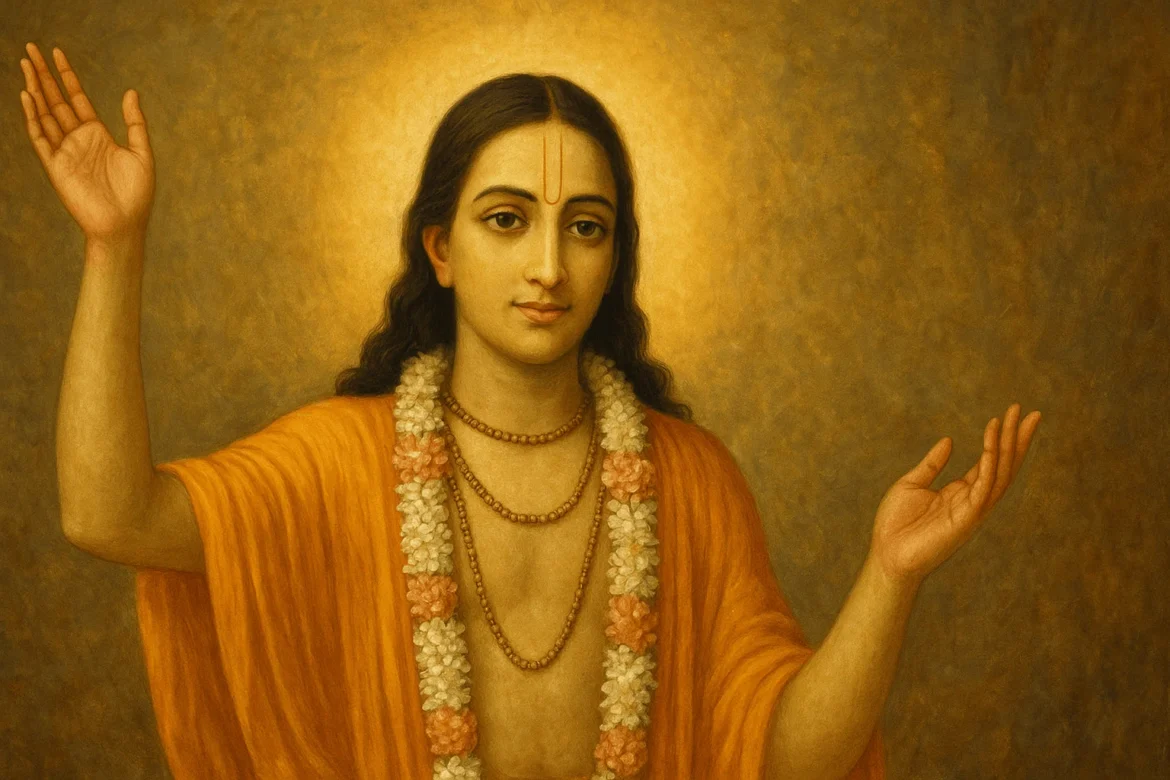1. The Golden Avatar of Bhakti
In the annals of India’s spiritual history, few figures shine as brightly as Chaitanya Mahaprabhu, also known as Lord Gauranga. Born in the 15th century, He is revered as the supreme incarnation of Lord Krishna in the mood of devotion. His life and teachings revolutionized spiritual practice, bringing Bhakti Yoga—the path of love and devotion—into the hearts of millions. Today, His name resonates not just in India but across the world, inspiring people to seek a personal and loving relationship with the Divine.
Chaitanya Mahaprabhu’s journey is not just a story of miracles and devotion; it is a spiritual blueprint. Through His life, He demonstrated that pure love and surrender to God transcend social divisions, caste, creed, or status. The essence of His message is simple yet profound: chant the holy names of Krishna with love, and attain divine bliss.
2. Birth and Early Life in Navadvipa
Chaitanya Mahaprabhu was born in 1486 CE in Navadvipa, a town on the banks of the Ganges in present-day West Bengal. His father, Jagannath Mishra, was a respected scholar, and his mother, Sachi Mata, was known for her piety. From a very young age, Chaitanya exhibited signs of divine consciousness, showing unusual compassion, intelligence, and spiritual inclination.
As a child, He was deeply absorbed in spiritual thoughts and often spent time in meditation and devotional practices. His early life was marked by simplicity, humility, and a deep love for Lord Krishna. People around Him noticed an extraordinary glow in His eyes and a profound sense of peace that set Him apart from other children.
During His school years, Chaitanya displayed remarkable intellect and mastery over scriptures. Yet, despite His brilliance, He remained detached from worldly ambitions, signaling a destiny far greater than scholarly achievements. These formative years laid the foundation for His future mission—the propagation of universal love and devotion through Bhakti.
3. The Divine Awakening
The turning point in Chaitanya Mahaprabhu’s life came during His adolescence. While still a young boy, He experienced intense spiritual ecstasy upon learning about the supreme love of Radha and Krishna. This love ignited an inner transformation, awakening in Him the desire to dedicate His entire life to spreading the love of God.
As He grew older, Chaitanya embraced the path of renunciation. He left behind family comforts to immerse Himself fully in devotional service and kirtan (chanting of holy names). His singular focus was on nama-sankirtan, the congregational chanting of Krishna’s holy names, which He believed was the most powerful means for attaining God-realization in this age.
This period also marked His recognition as a spiritual guide. Devotees and scholars alike were drawn to His wisdom, humility, and profound understanding of the Bhagavad Gita and Srimad Bhagavatam. What distinguished Him from others was not just His knowledge, but the transformative power of His love, which could awaken devotion in even the most skeptical hearts.
4. The Mission of Love and Devotion
Chaitanya Mahaprabhu’s mission was clear: to spread the practice of Bhakti and the chanting of Krishna’s holy names to everyone, regardless of social standing or caste. At that time, India was experiencing social divisions, ritualistic formalities, and spiritual stagnation. Mahaprabhu challenged these barriers by emphasizing that love and devotion were accessible to all, not just the learned or the elite.
He traveled extensively across Bengal, Odisha, and other regions, inspiring communities to come together in sankirtan, a joyous, collective chanting of the divine names. His influence was so profound that people from all walks of life—merchants, scholars, farmers, and even kings—felt drawn to His magnetic personality and compassionate heart.
Through His teachings, He demonstrated that true spirituality is not about renunciation of the world alone, but about cultivating love, compassion, and service in daily life. His life became a living example of devotion in action, showing that spiritual realization is attainable through humility, prayer, and heartfelt love for God.
5. Teachings and Philosophy of Chaitanya Mahaprabhu
The teachings of Chaitanya Mahaprabhu are the foundation of the Gaudiya Vaishnavism tradition, a devotional path centered on Krishna consciousness. His core philosophy includes:
1. Nama-sankirtan (Chanting the Holy Names): The simplest yet most potent form of spiritual practice, capable of purifying the heart and awakening divine love.
2. Bhakti over Rituals: While scriptures and rituals have value, devotion and love for God are supreme. True spirituality comes from the heart.
3. Universal Love and Equality: Mahaprabhu emphasized that everyone, regardless of caste, creed, or gender, can access God through sincere devotion.
4. Humility and Service: A devotee’s progress is measured not by knowledge alone but by love, compassion, and selfless service.
5. Radha-Krishna Love: Mahaprabhu highlighted that the divine love exemplified by Radha and Krishna is the highest form of spiritual expression, inspiring devotees to cultivate selfless love for God.
His teachings remain relevant today, guiding millions worldwide toward a life of compassion, devotion, and inner joy.
6. Miracles, Travels, and the Spread of the Holy Name
Chaitanya Mahaprabhu’s life was adorned with numerous divine pastimes and miracles that reinforced His spiritual stature. Stories of His miraculous powers, healing abilities, and profound wisdom spread far and wide, attracting disciples and devotees.
He traveled extensively, visiting sacred sites, meeting saints, and inspiring communities to chant Krishna’s holy names. During His journeys, He engaged in deep discussions on theology, guided aspiring devotees, and performed sankirtan in villages, towns, and temples.
One of His greatest contributions was demonstrating that spiritual ecstasy and divine love are not bound by caste, geography, or social status. Whether in the streets of Navadvipa or the villages of Odisha, His presence inspired joy, peace, and devotion.
7. The Golden Era of Kirtan and Bhakti Movement
Through Chaitanya Mahaprabhu, the Bhakti movement in Bengal and surrounding regions reached a golden era. He popularized kirtan and bhajan (devotional singing) as the most effective medium to connect with God. This congregational chanting created a sense of unity, joy, and spiritual awakening among people of all backgrounds.
His influence extended beyond religious boundaries. Even scholars and intellectuals recognized the transformative power of devotion, which could dissolve ego, promote compassion, and cultivate inner bliss. Mahaprabhu’s emphasis on love as the path to God inspired generations, shaping Indian devotional culture for centuries to come.
8. Final Years and Spiritual Legacy
Chaitanya Mahaprabhu’s later years were devoted to deep meditation, teaching His closest disciples, and spreading the practice of pure Bhakti. His humility, compassion, and unwavering dedication became a living testament to the power of divine love.
Although His earthly pastimes concluded around 1534 CE, His spiritual presence continues to inspire millions. Through His disciples, writings, and the ongoing practice of nama-sankirtan, His teachings remain alive, guiding seekers on the path of love, devotion, and spiritual fulfillment.
9. Influence on Modern Times and Global Devotion
The influence of Chaitanya Mahaprabhu extends far beyond India. Today, movements like the International Society for Krishna Consciousness (ISKCON) carry forward His mission of spreading Krishna devotion worldwide. His emphasis on chanting the holy names, loving God, and serving humanity has touched the lives of millions across continents.
His life serves as a reminder that spiritual transformation is universal, accessible to anyone willing to surrender to divine love. By embracing His teachings, modern devotees find a path of inner peace, joy, and purpose, even in today’s fast-paced world.
10. Conclusion: The Eternal Message of Compassion
Chaitanya Mahaprabhu’s life is a shining example of divine love, humility, and devotion. He taught that the essence of spirituality is not ritual alone but a heart overflowing with love for God. Through His life, travels, teachings, and miracles, He demonstrated that pure Bhakti transcends social boundaries, personal ambition, and worldly attachments.
The message of Chaitanya Mahaprabhu is eternal:
Chant the holy names with devotion
Love and serve all beings
Embrace humility and compassion
Spread joy and divine consciousness wherever you go
In following this path, one not only connects with the Divine but also transforms the world into a place of love, harmony, and spiritual awakening. Today, His name, teachings, and pastimes continue to inspire seekers, making Chaitanya Mahaprabhu a timeless beacon of universal love and Bhakti.

